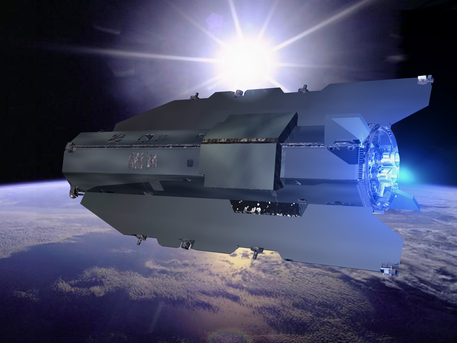Changing trajectories
Do satellites need constant propulsion?
 © ESA
|
The GOCE (Gravity field and steady-state ocean circulation explorer) will map the Earth's gravity field and orbit at a "small" distance of 260 kilometers from the surface. So GOCE has a sleek aerodynamic design and is equipped with special ion thrusters.
Traces of the Earth's atmosphere, which extend for hundreds of kilometers beyond the surface of the Earth, can have particularly strong perturbing effects. Friction with gas molecules of this residual atmosphere slows down every object that orbits the Earth, gradually bringing it down into a lower orbit. The GOCE satellite, scheduled to be launched this year, will be particularly affected by this problem. It will orbit at a relatively small distance of 260 kilometers (approximately 160 miles) from the surface of the Earth. For this reason, GOCE has a sleek aerodynamic design and comes equipped with special ion thrusters. These thrusters can accelerate the satellite and bring it back into a higher orbit or keep it in its designated orbit - this is called orbit control.
Satellites use rocket propulsion for attitude and orbit control.
In addition to this, satellites also need rocket propulsion systems so that they can be oriented in a certain direction - so for attitude control. This is necessary to ensure that the on-board camera is pointing towards the Earth, or that the solar arrays always face the Sun. For this reason, a satellite is equipped with a large number of small thrusters on its outer surface. These thrusters are fired briefly when required, so that the satellite starts to rotate slowly. As soon as the satellite has reached the desired position, thrusters are activated that fire in the opposite direction in order to stop the rotation.
Credit: German Aerospace Center
Changing trajectories
Do satellites need constant propulsion?
 © ESA
|
The GOCE (Gravity field and steady-state ocean circulation explorer) will map the Earth's gravity field and orbit at a "small" distance of 260 kilometers from the surface. So GOCE has a sleek aerodynamic design and is equipped with special ion thrusters.
Traces of the Earth's atmosphere, which extend for hundreds of kilometers beyond the surface of the Earth, can have particularly strong perturbing effects. Friction with gas molecules of this residual atmosphere slows down every object that orbits the Earth, gradually bringing it down into a lower orbit. The GOCE satellite, scheduled to be launched this year, will be particularly affected by this problem. It will orbit at a relatively small distance of 260 kilometers (approximately 160 miles) from the surface of the Earth. For this reason, GOCE has a sleek aerodynamic design and comes equipped with special ion thrusters. These thrusters can accelerate the satellite and bring it back into a higher orbit or keep it in its designated orbit - this is called orbit control.
Satellites use rocket propulsion for attitude and orbit control.
In addition to this, satellites also need rocket propulsion systems so that they can be oriented in a certain direction - so for attitude control. This is necessary to ensure that the on-board camera is pointing towards the Earth, or that the solar arrays always face the Sun. For this reason, a satellite is equipped with a large number of small thrusters on its outer surface. These thrusters are fired briefly when required, so that the satellite starts to rotate slowly. As soon as the satellite has reached the desired position, thrusters are activated that fire in the opposite direction in order to stop the rotation.
Credit: German Aerospace Center







